The 12 Sharp Keys
Below are the 12 sharp key signatures in order of the number of sharps. It is worth noting that F# Major and Gb Major and harmonically equivalent.

The 12 Flat Keys
Below are the 12 flat keys in Western music in order of the number of flats.

What are Key Signatures?
A key signature is the melodic foundation of a piece of music. The notes in the key signature are the core notes that used to create chords and the melody of the piece.
Key signatures are found at the start of a piece of music, after the clef and before the time signature (or meter). They tell you which sharps and flats are in the music.
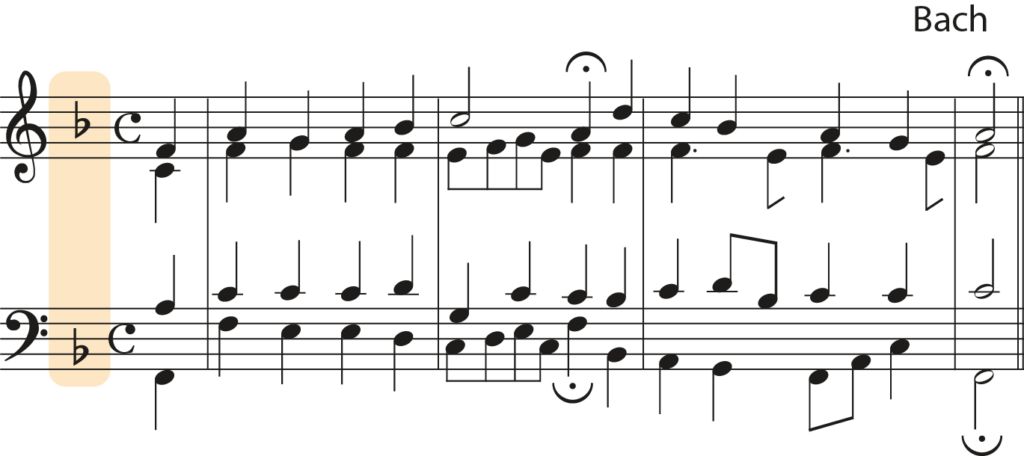
For example the below piece is in A Major and so the note A would be the tonic note of the scale. In this key we have three sharps, F#, C# and D#. This means that all F, C and D notes are automatically sharpened in the music, unless there is a natural sign before them. You can see a natural sign in bar 4.
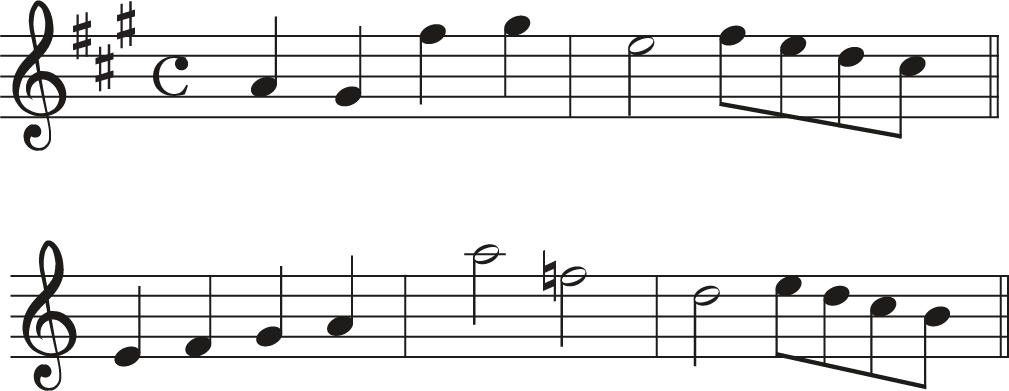
How are key signatures formed?
If we take the pattern of the major scale and apply it to each note in turn, we can create all the major scales complete with all their sharps and flats.
The major scale is created by the tonal pattern: tone, tone, semitone, tone, tone, tone, semitone. You can see this below starting on a C, to create the C Major scale.
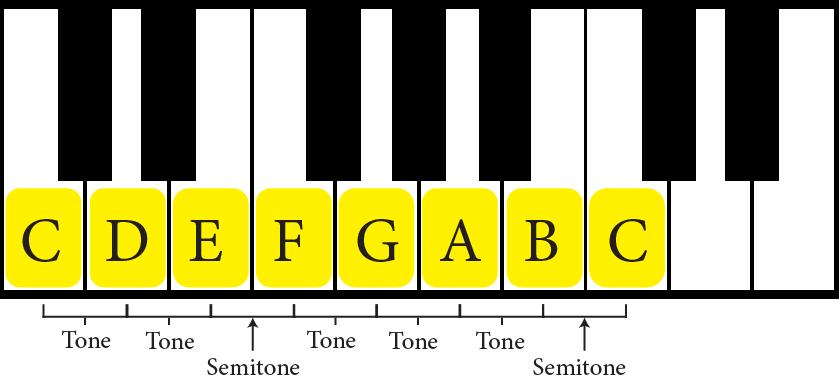
Here is the pattern again starting on B to create the B major scale.

As you can see, B major has five sharps. If we wanted to compose a piece in B major, we would start with a key signature with a F#, C#, G#, D# and A#.
The order of the sharps and flats
There is a specific order of sharps and flats when writing key signatures. For sharp key signatures, the order is F#, C#, G#, D#, A#, E# and B#. You could remember this with a pneumonic such as Father Christmas Gives Dad An Electric Blanket.
The order of the flat key signatures is Bb, Eb, Ab, Db, Gb, Cb and Fb. You could remember this with the pneumonic Blanket Explodes And Dad Gets Cold Feet.
Circle of Fifths and Key Signatures
C Major is a unique key signature in that it has no sharps or flats in it. This comes at the top of the circle of fifths. The fifths note of C Major is G, so G major is next (moving clockwise) and has one sharp. The fifth note in G major is a D, so D Major has two sharps. This continues all the way to F# Major with its six sharps.
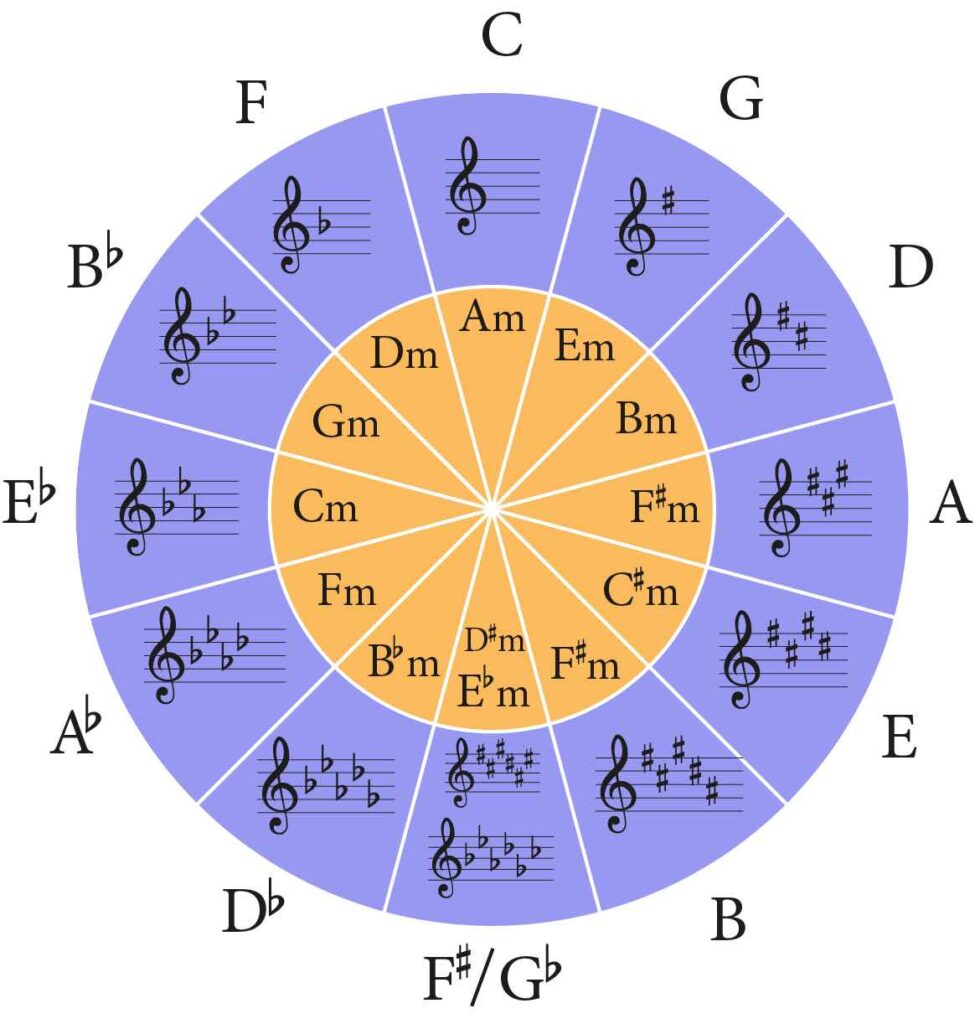
Starting from C Major again, but moving counter-clockwise, we have to go a 5th below C. A 5th below C is F, so F major has one flat. A fifth below F is Bb, so Bb major has two flats. For more on how these intervals work see our guide to the circle of fifths.
This gives us all 12 major key signatures.
What about minor key signatures?
Each major key has a relative minor key that has the same key signature (same sharps or flats). To find the relative minor key go to the sixth note of the major scale. For example, the sixth not of E major is C#, so C# Minor shares a key signature with E Major. You can see all of the relative minor keys on the circle of fifths. Learn more about minor keys with with our guide to all three minor scales.

Learn more about the circle of fifths with our complete guide.
Enharmonic Equivalent Key Signatures
You might have noticed that F# Major and Gb major are both in the bottom section of the circle of fifths. This is because these are enharmonic equivalent keys. If we look at both scales on the piano, we can see that they are two different ways of showing the same notes.
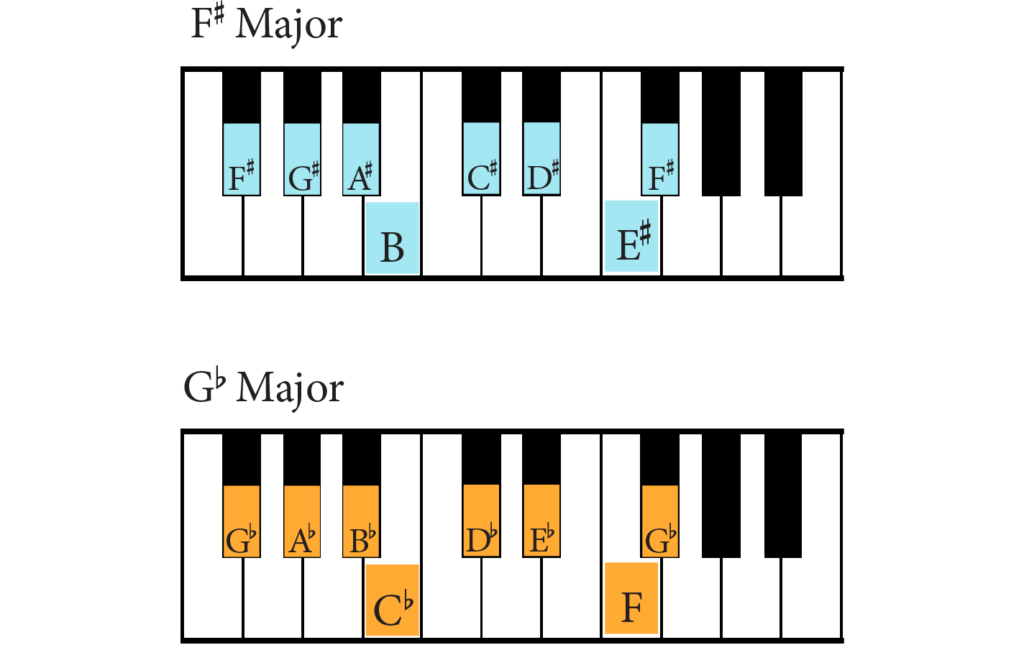
We also have two other keys that are rare used as they are enharmonic equivalents to other (simpler) keys. Take a look below at this complete circle of fifths and you will spot the keys of C# Major and Cb Major.
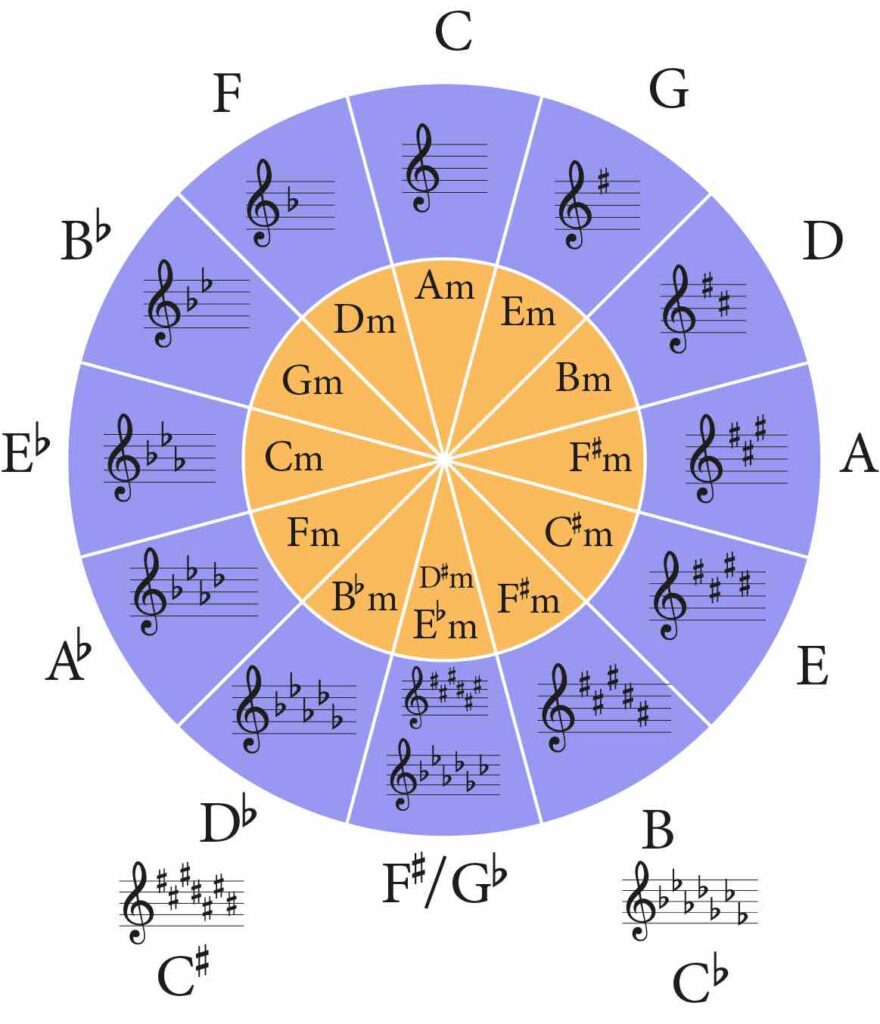
C# Major has 7 sharps – F#, C#, G#, D#, A#, E#, B#. It is the enharmonic equivalent of Db Major. Take a look below and you can see that they have exactly the same notes in them.
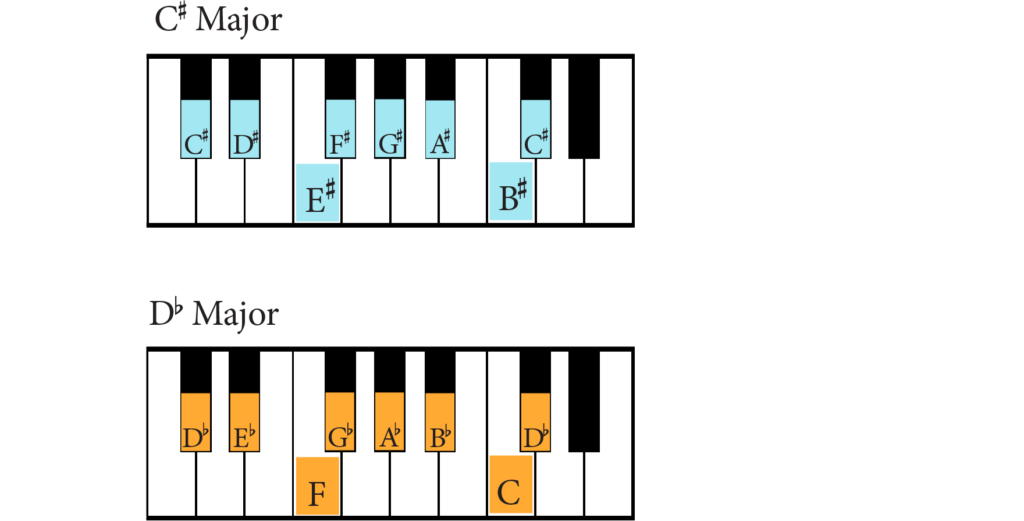
Cb Major has 7 flats – Bb, Eb, Ab, Db, Gb, Cb, Fb. It is the enharmonic equivalent of B major, which has five sharps, but exactly the same notes in it.
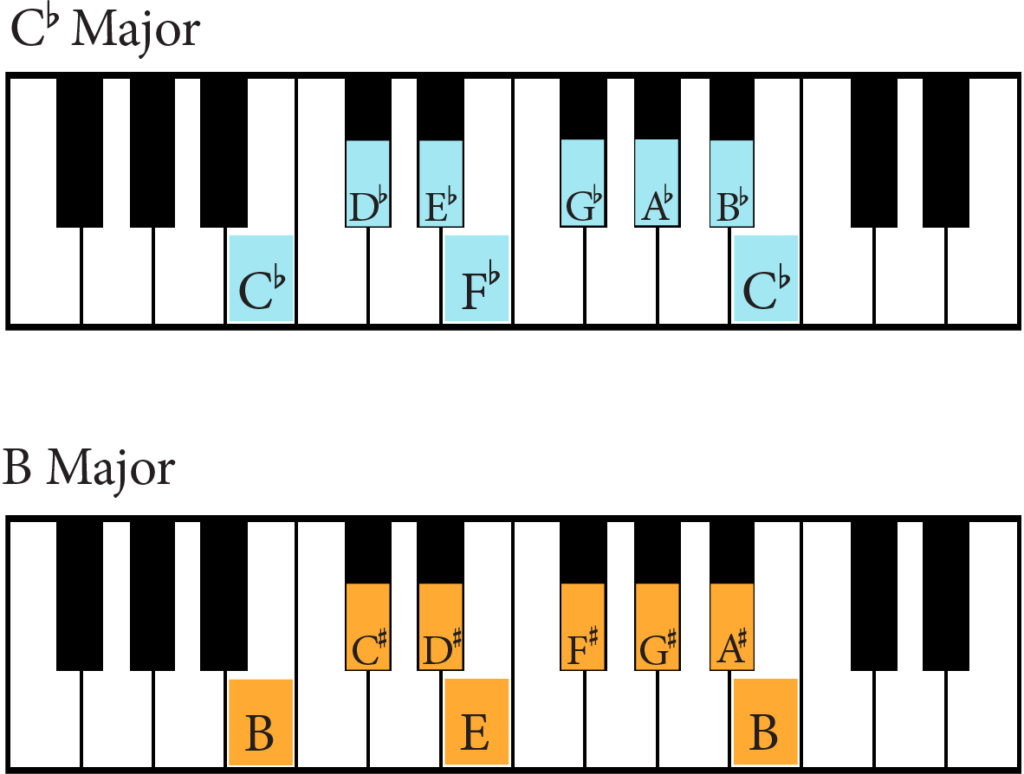
How to write key signatures
Key signatures have a specific way that they must be written. The sharps and flats in each key must be written in order from left to right.
Sharp order: F#, C#, G#, D#, A#, E#, B#
Flat order: Bb, Eb, Ab, Db, Gb, Cb, Fb
When writing key signatures we must also be aware of the clef we are in. The order stays the same for the sharps and flats but they may fall differently on the stave.
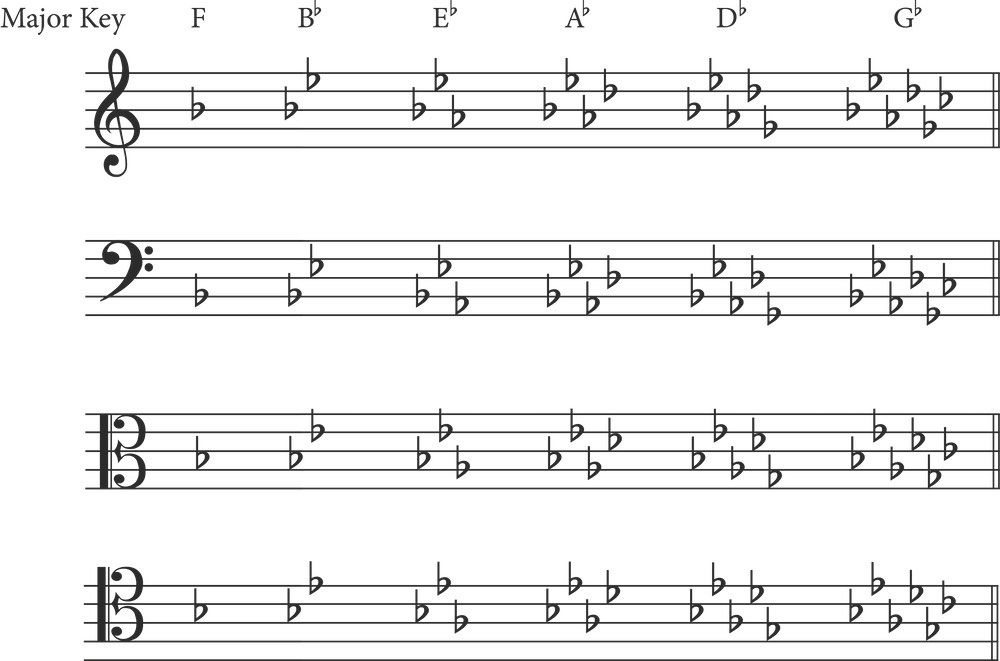

Note that the sharps and flats still alternative with the high, low, high, low pattern continuing the same for all clefs.
The exception is the sharp keys in the tenor clef. Notice how the F# is written low on the stave rather than high.
What is the difference between a ‘key’ and a ‘scale’?
Sometimes people use both words to mean the same thing but there is an important difference. The key of piece of music is its melodic foundation. If a piece of music uses chords with most of their notes from the G Major scale, then we can say that the piece is in the key of G Major. However the melody does not have to only use the G Major scale. The musicians could use a blues scale or mode, such as the dorian mode. Many scales can be used within a piece in the key of G to give it a completely different sound.
When using minor keys, it is important to remember that the key signature is for the natural minor. For example we would create a piece in the key of A minor, so the key signature would have no sharps or flats. We might add in extra notes to use the melodic or harmonic minor scales. If we did this, the piece is still said to be in A Minor, NOT A melodic minor, or A harmonic minor. We are simply using these other scales within the piece.
If you want to leaner bout scales, they head over to our scales and chords blog posts.
What are key changes?
The key can change in a piece of music and it would be shows in the music as a new key signature. Alternatively, there could be accidentals added instead and no new key signature in the music. Either way the same things has happened, the key has changed!
Examples of Key Changes
In pop music a key change can be used as an uplifting end to a song, often in the last chorus. The most cheesy key change usually involves moving the key up a semitone (think Westlife). Other key changes, like Bon Jovi- Livin’ on a Prayer move up a whole tone. (Stacey’s Mom by Fountains of Wayne goes up three semitones). Check out these examples below.
Fountains of Wayne – Stacey’s Mom – Key change at 2:16
Genesis and Phil Colins – Invisible Touch 3:07
Bon Jovi – Linvin’ on a Prayer – 3:25
FAQs
Is the key of E higher than the key of D?
This is a common misconception. Although an E note is higher than a D in the same octave, this does not have to be true of a piece in these keys. I could write a piece in D Major that used very high notes in the scale and a piece in the key of E that had a much lower range of notes used. The key does give us this information, we would need to read the music or hear it being played.
How to tell what key a song is in
This can by tricky for beginners, but the best way is to see what chords are used in the piece. If the chords are mostly using notes from one scale then this will be the key. Try to find the tonic of the major or minor scale being used.
Which key is the highest?
There is no such thing as a high key or a low key. Two pieces in the same key could have a very different range of notes. Remember that the same chord progression or melody could be played up or down octaves, but they would all be in the same key.
Which key has the most sharps?
C# Major has six sharps – F#, C#, G#, A#, E#, B#. This is not often used as it is enharmonically equivalent to Db Major (which has a much easier 5 flats).
Which key has the most flats?
Cb Major has six flats – Bb, Eb, Ab, Db, Gb, Cb, Fb. It is not often used as it is enharmonically equivalent to B major (which has a more manageable five sharps instead).
